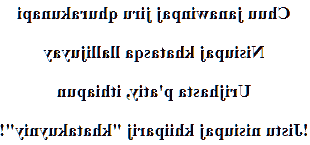Callawalla love poem
Jiru qhurakuna
Chuu janawinpaj jiru qhurakunapi
Nisiupaj khatasqa llallijuyay
Urijhasta p'atiy, ithiapun
!Jistu nisiupaj khiiparij "khatakuyniy"!


→ French poem ←
Callawalla language
The Mach'aj yuyay = language of men (Kallawaya, Callawalla, Callawaya, Callahuaya, Pohena), is a language in great danger.
Callawalla is spoken in the department of La Paz, in the northeast of Lake Titicaca, more precisely in the Bolivian Andes around Charazani, in the villages of Chajaya, Kalulaya, Curva, Wata-Wata and Chari.
This area that linked Cuzco to Potosí was trilingual: Aymara, Uru-Puquina, Quechua.
Kallawaya is often considered a mixed language that uses a non-Quechua word system in Quechua sentences.
Also, some linguists link Mach'a to the extinct language Puquina (Pukina) and a southern Quechua brought by the Incas.
Callawaya is an "esoteric" language used for ritual purposes. It is also called "the secret language of the Incas", and today it is only spoken by about ten people, who are traditional healers, great experts of herbalism.
It is likely that Callawalla has never been a mother tongue, but a language reserved for the medical rites of the Kallawaya community... but this remains a debate between linguists.
If the natives of this region of the Andes speak Aymara, Charazani and its surroundings, which are populated by descendants of the Mitimaes (Mitmacs) remain a Quechua linguistic enclave.
Mitmac, which means to scatter in Quechua, designates the people that the Incas moved in large numbers to other parts of their vast empire... the goal being to divide all these populations to better reign.
Among the Callawallas, the legend tells that the two great mountains, Sunchuli and Acamani brought them their language, two summits considered as protectors, since other legends suggest that they buried their enemies under the snow.
The Callawallas
The Callawallas are known as herbal healers. They also practice divination and magic.
Sebastián Quispe Calancha is one of these healing herbalists, he practices this ancient Kallawaya medicine.
These herbalists themselves, are often the descendants of renowned healers. They are itinerant and go to the sicks. They are sometimes called upon, thousands of miles away.
Their talent is transmitted, and the oldest initiate the youngest from adolescence, using them as apprentices.
The word Kallawaya comes from the Quechua, Kholla-Huatani = medicines-tie, in relation to their activity: those who transport medicines.
Indeed, during their roaming, they take with them a large bag containing a whole bunch of small sachets containing herbal substances prepared in medicinal forms.
They also carry with them amulets and sachets containing mineral and animal substances (clay, bones, feathers, etc.).
For the Kallawayas there are natural illnesses and those with magical origin caused by spirits. This second category cannot of course be cured by modern medicine, and the secrets they hold, and even that of their language, are necessarily a precious help in penetrating the mysteries of the occult.
Since 2003, the Kallawaya culture has been decreed Intangible Oral Heritage of Humanity.